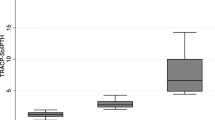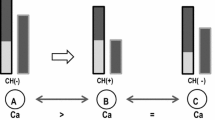Abstract
The aim of the present study was to examine whether the newly developed bio-intact parathyroid hormone (Bio-PTH) assay, which exclusively measures the intact PTH(1–84) molecule, provides a better assay for estimating parathyroid function in hemodialysis (HD) patients, and to evaluate the factors associated with serum PTH levels measured by Bio-PTH assay and by second-generation intact PTH (I-PTH) assay. The study also examined whether Bio-PTH/I-PTH ratio, an index of the active fraction of PTH, could provide information not obtainable from simple PTH results. Serum levels of PTH were measured in 177 male HD patients, together with the bone formation markers bone alkaline phosphatase (BAP), intact osteocalcin (iOC), N-midfragment osteocalcin (N-Mid OC), and N-terminal propeptide of type I collagen (PINP), and the bone resorption markers deoxypyridinoline (DPD), pyridinoline (PYD), and β-CrossLaps (β-CTx). Bone mineral density (BMD) was determined twice at distal radius one-third by dual-energy X-ray absorptiometry. Serum Bio-PTH was significantly elevated in HD patients compared to normal controls. Serum Bio-PTH and I-PTH correlated significantly in a positive manner with serum bone formation markers (BAP, iOC, N-Mid OC, PINP), and resorption markers (DPD, PYD, β-CTx), and in a negative manner with BMD and annual change therein at distal radius one-third. The degree of correlation of Bio-PTH was not significantly different from that of I-PTH. The Bio-PTH/I-PTH ratio was significantly lower in HD patients than in normal individuals, due probably to accumulation of N-truncated PTH fragments in the former. The Bio-PTH/I-PTH ratio correlated significantly in a negative manner with serum calcium (Ca) (r=−0.251, P<0.001) and nutritional marker serum urea nitrogen, protein catabolic rate and serum creatinine. Multiple regression analysis further revealed that serum I-PTH, but not Bio-PTH, was significantly associated with each of these nutritional markers, and that the Bio-PTH/I-PTH ratio was negatively associated with serum Ca. It was also found that I-PTH, but not Bio-PTH, was influenced by nutritional state. It is concluded that serum Bio-PTH assay could be of similar value to I-PTH assay in evaluating parathyroid function in HD patients and that their combined use in the form of the Bio-PTH/I-PTH ratio could provide information not obtainable from simple PTH results.





Similar content being viewed by others
References
Lepage R, Roy L, Brossard JH, Rousseau L, Dorais C, Lazure C, D’Amour P (1998) A non-(1–84) circulating parathyroid hormone (PTH) fragment interferes significantly with intact PTH commercial assay measurements in uremic samples. Clin Chem 44:805–809
Brossard JH, Cloutier M, Roy L, Lepage R, Gascon-Barre M, D’Amour P (1996) Accumulation of a non-(1–84) molecular form of parathyroid hormone (PTH) detected by intact PTH assay in renal failure: importance in the interpretation of PTH values. J Clin Endocrinol Metab 81:3923–3929
Brossard JH, Lepage R, Cardinal H, Roy L, Rousseau L, Dorais C, D’Amour P (2000) Influence of glomerular filtration rate on non-(1–84) parathyroid hormone (PTH) detected by intact PTH assays. Clin Chem 46:697–703
Slatopolsky E, Finch J, Clay P, Martin D, Sicard G, Singer G, Gao P, Cantor T, Dusso A (2000) A novel mechanism for skeletal resistance in uremia. Kidney Int 58:753–761
Nguyen-Yamamoto L, Rousseau L, Brossard JH, Lepage R, D’Amour P (2001) Synthetic carboxyl-terminal fragments of parathyroid hormone (PTH) decrease ionized calcium concentration in rats by acting on a receptor different from the PTH/PTH-related peptide receptor. Endocrinology 142:1386-1392
Langub MC, Monier-Faugere M-C, Wang G, Williams JP, Koszewski NJ, Malluche HH (2003) Administration of PTH-(7–84) antagonizes the effects of PTH-(1–84) on bone in rats with moderate renal failure. Endocrinology 144:1135–1138
Divieti P, John MR, Juppner H, Bringhurst FR (2002) Human PTH-(7–84) inhibits bone resorption in vitro via actions independent of the type I-PTH/PTHrP receptor. Endocrinology 143:171–176
Segre GV, Niall HD, Habener JF, Potts JT Jr (1974) Metabolism of parathyroid hormone: physiological and clinical significance. Am J Med 56:774–784
Nguyen-Yamamoto L, Rousseau L, Brossard JH, Lepage R, Gao P, Cantor T, D’Amour P (2002) Origin of parathyroid hormone (PTH) fragments detected by intact-PTH assays. Eur J Endocrinol 147:123–131
D’Armour P, Lazure C (1985) Metabolism of radioiodinated carboxyterminal fragments of bovine parathyroid hormone in normal and anephric rats. Endocrinology 117:127–134
Mayer GP, Keaton JA, Hurst JG, Habener JF (1979) Effects of plasma calcium concentration on the relative proportion of hormone and carboxyl fragments in parathyroid venous blood. Endocrinology 104:1778–1784
Watson PH, Hanley DA (1993) Parathyroid hormone: regulation of synthesis and secretion. Clin Invest Med 16:58–77
Quarles LD, Lobaugh B, Murphy G (1992) Intact parathyroid hormone overestimates the presence and severity of parathyroid-mediated osseous abnormalities in uremia. J Clin Endocrinol Metab 75:145–150
Inaba M, Nakatuska K, Imanishi Y, Watanabe M, Mamiya Y, Ishimura E, Nishizawa Y (2004) Technical and clinical characterization of the Bio-PTH (1–84) immunochemiluminometric assay and comparison with a second-generation assay for parathyroid hormone. Clin Chem 50:385–390
John MR, Goodman WG, Gao P, Cantor TL, Salusky IB, Juppner H (1999) A novel immunoradiometric assay detects full-length human PTH but not amino-terminally truncated fragments: implications for PTH measurements in renal failure. J Clin Endocrinol Metab 84:4287–4290
Gao P, Scheibel S, D’Amour P, John MR, Rao SD, Schmidt-Gayk H, Cantor TL (2001) Development of a novel immunoradiometric assay exclusively for biologically active whole parathyroid hormone 1–84: implications for improvement of accurate assessment of parathyroid function. J Bone Miner Res 16:605–614
Ishimura E, Okuno S, Kim M, Yamamoto T, Izumotani T, Otoshi T, Shoji T, Inaba M, Nishizawa Y (2001) Increasing body fat mass in the first year of hemodialysis. J Am Soc Nephrol 12:1921–1926
Inaba M, Morii H, Katsumata T, Goto H, Ishimura E, Kawagishi T, Kamao M, Okano T, Nishizawa Y (2000) Hyperparathyroidism is augmented by ovariectomy in Nagase analbuminemic rats. J Nutr 130:1543–1547
Inaba M, Nishizawa Y, Mita K, Kumeda Y, Emoto M, Kawagishi T, Ishmura E, Nakatsuka K, Shioi A, Morii H (1999) Poor glycemic control impairs the response of biochemical parameters of bone formation and resorption to exogenous 1,25-dihydroxyvitamin D3 in patients with type 2 diabetes. Osteoporos Int 9:525–531
Inaba M, Terada M, Nishizawa Y, Shioi A, Ishimura E, Otani S, Morii H (1999) Protective effect of an aldose reductase inhibitor against bone loss in galactose-fed rats: possible involvement of the polyol pathway in bone metabolism. Metabolism 48:904–909
Kumeda Y, Inaba M, Tahara H, Kurioka Y, Ishikawa T, Morii H, Nishizawa Y (2000) Persistent increase in bone turnover in Graves’ patients with subclinical hyperthyroidism. J Clin Endocrinol Metab 85:4157–4161
Gomes B Jr, Ardakani S, Ju J, Jenkins D, Cerelli MJ, Daniloff GY, Kung VT (1995) Monoclonal antibody assay for measuring bone-specific alkaline phosphatase activity in serum. Clin Chem 41:1560–1566
Takahashi M, Kushida K, Nagano A, Inoue T (2000) Comparison of the analytical and clinical performance characteristics of an N-MID versus an intact osteocalcin immunoradiometric assay. Clin Chim Acta 294:67–76
Nagasue K, Inaba M, Okuno S, Kitatani K, Imanishi Y, Ishimura E, Miki T, Kim M, Nishizawa Y (2003) Serum N-terminal midfragment vs. intact osteocalcin immunoradiometric assay as markers for bone turnover and bone loss in hemodialysis patients. Biomed Pharmacother 57:98–104
Ueda M, Inaba M, Okuno S, Nagasue K, Kitatani K, Ishimura E, Shimizu M, Kim M, Nishizawa Y (2002) Clinical usefulness of the serum N-terminal propeptide of type I collagen as a marker of bone formation in hemodialysis patients. Am J Kidney Dis 40:802–809
Inaba M, Nagasue K, Okuno S, Ueda M, Kumeda Y, Imanishi Y, Shoji T, Ishimura E, Ohta T, Nakatani T, Kim M, Nishizawa Y (2002) Impaired secretion of parathyroid hormone, but not refractoriness of osteoblast, is a major mechanism of low bone turnover in hemodialyzed patients with diabetes mellitus. Am J Kidney Dis 39:1261–1269
Furumitsu Y, Inaba M, Yukioka K, Yukioka M, Kumeda Y, Azuma Y, Ohta T, Ochi T, Nishizawa Y, Morii H (2000) Levels of serum and synovial fluid pyridinium crosslinks in patients with rheumatoid arthritis. J Rheumatol 27:64–70
Niwa T, Shiobara K, Hamada T, Miyazaki T, Tsukushi S, Uema K, Tsuzuki T (1995) Serum pyridinolines as specific markers of bone resorption in hemodialyzed patients. Clin Chim Acta 235:33–40
Okabe R, Nakatsuska K, Inaba M, Miki T, Naka H, Masaki H, Moriguchi A, Nishizawa Y (2001) Clinical evaluation of the Elecsys β-CrossLaps serum assay, a new assay for degradation products of type I collagen C-telopeptides. Clin Chem 47:1410–1414
Okabe R, Inaba M, Nakatsuka K, Miki T, Naka H, Moriguchi A, Nishizawa Y (2004) Significance of serum CrossLaps as a predictor for changes in bone mineral density during estrogen replacement therapy; comparison with serum carboxyterminal telopeptide of type I collagen and urinary deoxypyridinoline. J Bone Miner Metab 22:127–131
Avram MM, Mittman N, Myint MM, Fein P (2001) Importance of low serum intact parathyroid hormone as a predictor of mortality in hemodialysis and peritoneal dialysis patients: 14 years of prospective observation. Am J Kidney Dis 38:1351–1357
Salusky IB, Goodman WG, Kuizon BD, Lavigne JR, Zahranik RJ, Gales B, Wang HJ, Elashoff RM, Juppner H (2003) Similar predictive value of bone turnover using first- and second-generation immunometric PTH assays in pediatric patients treated with peritoneal dialysis. Kidney Int 63:1801–1808
Monier-Faugere MC, Geng Z, Mawad H, Friedler RM, Gao P, Cantor TL, Malluche HH (2001) Improved assessment of bone turnover by the PTH-(1–84)/large C-PTH fragments ratio in ESRD patients. Kidney Int 60:1460–1468
Coen G, Bonucci E, Ballanti P, Balducci A, Calabria S, Nicolai GA, Fischer MS, Lifrieri F. Manni M, Morosetti M, Moscaritolo E, Sardella (2002) PTH 1–84 and PTH “7–84” in the noninvasive diagnosis of renal bone disease. Am J Kidney Dis 40:348–354
Author information
Authors and Affiliations
Corresponding author
Rights and permissions
About this article
Cite this article
Inaba, M., Okuno, S., Imanishi, Y. et al. Significance of Bio-intact PTH(1–84) assay in hemodialysis patients. Osteoporos Int 16, 517–525 (2005). https://doi.org/10.1007/s00198-004-1715-1
Received:
Accepted:
Published:
Issue Date:
DOI: https://doi.org/10.1007/s00198-004-1715-1




